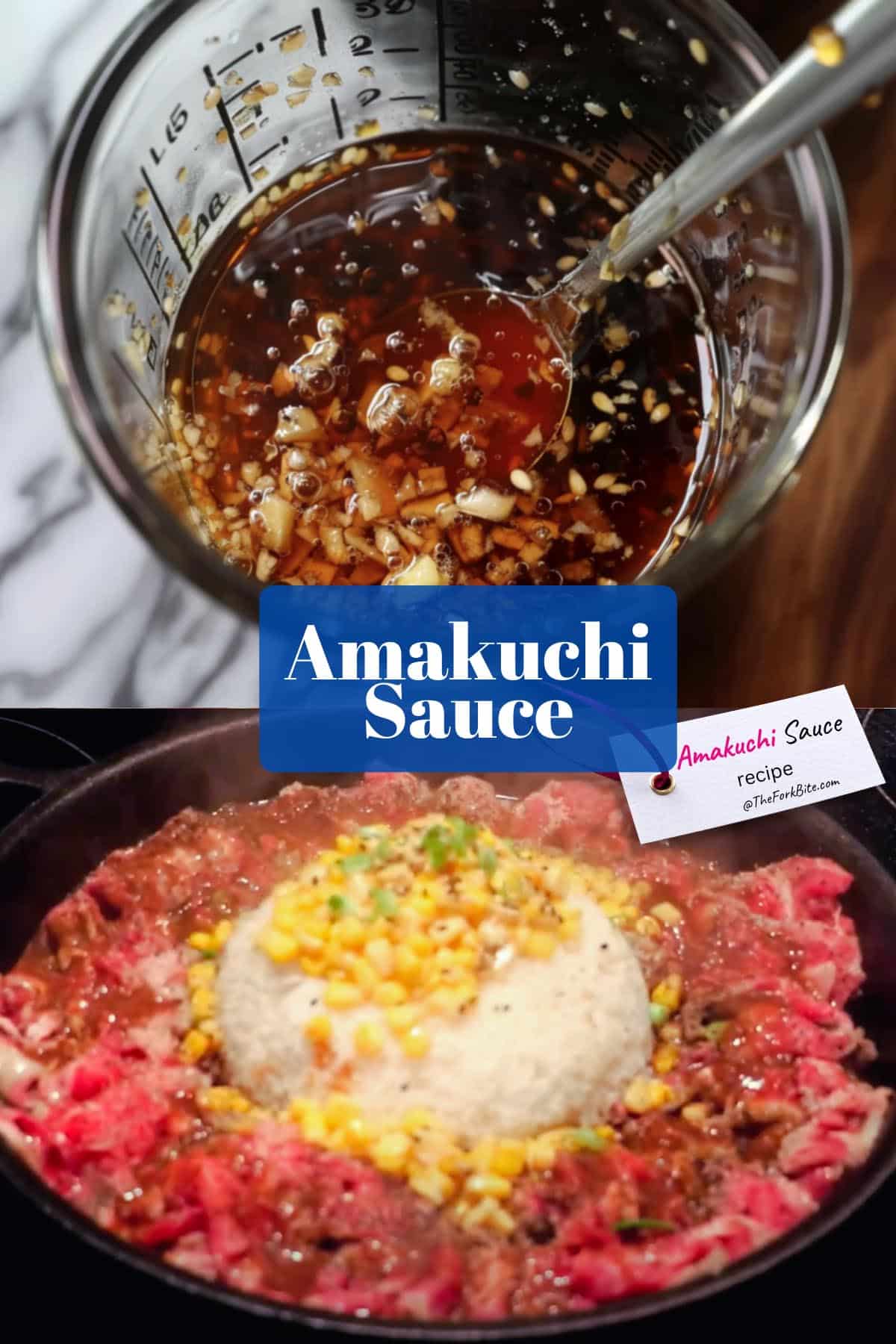Okay, I need to put you on to Amakuchi sauce. Think a little sweet, a little salty, and a whole lot of delicious. This Japanese sauce is about to transform your stir-fries, marinades, and dipping game.
Ever had food that just felt kinda flat? Amakuchi fixes that. It adds this caramelized, sweet-savory flavor that's seriously addictive.
In this post, I'm breaking down everything Amakuchi – what it is, the best ways to use it, and where to snag a bottle. Get ready to level up your cooking!

So, what exactly is Amakuchi sauce?
Let's break it down:
- The Basics: Amakuchi literally means "sweet taste" in Japanese. It's a type of soy sauce, but much sweeter than the regular stuff you're used to.
- How It's Made: It starts just like regular soy sauce – fermented soybeans, wheat, etc. But, here's the twist: extra wheat is added during the process, and that's what creates the signature sweetness.
- The Flavor: Imagine a balance of salty, savory soy sauce with a rich, almost caramel-like sweetness. It's less intense than something like teriyaki, and way more versatile.
Ingredients You'll need:
- 1 tablespoon Oil: Provides a base for cooking the vegetables and adds a bit of richness to the sauce. You can use neutral-flavored oils like canola or vegetable oil.
- ¼ cup Onions (diced): Onions add a mellow sweetness and savory depth to the sauce. Their aromatics also infuse into the oil as they cook, creating a more flavorful foundation.
- 3 cloves Garlic (minced): Garlic delivers a pungent, slightly spicy note that complements the other ingredients perfectly. Remember, fresh garlic is always best!
- Ginger: Adds a fresh, warm spiciness and a touch of zing to the sauce.
- ¼ cup light Soy Sauce (or Tamari for gluten-free): Soy sauce is the core savory component of the sauce. It contributes saltiness and that classic umami flavor. Tamari is a great substitute if you need a gluten-free option.
- 2 tablespoons Mirin (sweet rice wine): Mirin adds a subtle sweetness that balances the soy sauce. It also has a slightly fermented flavor that adds another layer of complexity to the sauce.
- 2 tablespoons Brown Sugar (or Honey): This ingredient is key for achieving the characteristic sweet taste of the sauce. Brown sugar adds a touch of caramel richness, while honey offers a more floral sweetness.
- Cornstarch Slurry (1 tablespoon cornstarch + ¼ cup water): The cornstarch slurry is essential for giving your sauce the right consistency. When heated, the cornstarch will thicken the liquid, creating a sauce that coats your stir-fries or other dishes beautifully.

Step by Step Guide
Sauté the Aromatics.
Heat the oil in a small saucepan over medium heat.Add the diced onions and cook until they soften and become translucent, about 2-3 minutes.
Stir in the minced garlic and cook for another 30 seconds, or until fragrant.
Combine the Sauce Ingredients.
Carefully pour in the soy sauce (or Tamari) and Mirin. Be mindful as it might splatter slightly when it hits the hot pan.
Add the brown sugar (or honey) and stir until dissolved.Allow the sauce to come to a gentle simmer.
Thicken with Cornstarch Slurry.
Give the cornstarch slurry a quick stir to recombine (the cornstarch settles).Slowly drizzle the cornstarch slurry into the simmering sauce (whether blended or not), stirring constantly.
Continue to cook for about 1 minute, or until the sauce thickens and becomes glossy.Remove the sauce from the heat.
(Optional) Blend for a Smoother Sauce.
(*Optional) Transfer the sauce to a blender and pulse until smooth.
Set aside.Use immediately on your favorite stir-fries, dipping sauces, marinades, or store in an airtight container in the refrigerator for later use.

Variations and Substitutes
- Spice It Up: Add a pinch of red pepper flakes, a hint of grated ginger, or a drizzle of chili oil for a touch of heat.
- Herbal Twist: Stir in finely chopped fresh herbs like cilantro or basil towards the end of cooking for a burst of freshness.
- Citrus Zing: Enhance the sauce with a squeeze of lemon, lime, or orange juice for a bright, acidic counterpoint to the sweetness.
- Mirin Alternatives: If you don't have Mirin, you can substitute it with a mixture of dry sherry and sugar or use equal parts rice vinegar with a bit more sugar.
- Soy Sauce Swaps: Use Tamari for a gluten-free version, coconut aminos for a soy-free option with a slightly sweeter flavor, or even a reduced-sodium soy sauce for a less salty sauce.
- Sweet Substitutions: Swap brown sugar with honey, maple syrup, agave nectar, or even a touch of molasses for a deeper flavor.
Related read:
Preservation and Storage Tips
- Refrigerate: Homemade Amakuchi sauce will keep well in the refrigerator for up to a week. Store it in an airtight container or jar.
- Reheating: Gently reheat the sauce in a saucepan over low heat, stirring occasionally, until warmed through.
- Freezing (Possible, but...): While Amakuchi sauce technically can be frozen, the texture may change slightly after defrosting. If you must freeze it, store it in small portions and thaw overnight in the refrigerator.
- Signs of Spoilage: Look for any mold, off-odors, or changes in texture as signs the sauce has gone bad. Remember, when in doubt, toss it out!
Extra Tip:
- Label It: When storing your homemade Amakuchi sauce, be sure to label the container with the date it was made for easy reference.
Amakuchi Sauce Uses
- Stir-fries: The classic! Amakuchi adds instant caramelization, sweetness, and depth to stir-fries with chicken, beef, tofu, or any mixed vegetables.
- Glazes: Brush onto grilled meats like salmon, pork chops, or chicken for a sweet and savory coating.
- Marinades: Use Amakuchi as a base for teriyaki-inspired marinades that tenderize meats and infuse them with flavor.
- Dipping Sauces: Amakuchi makes a fantastic dipping sauce for tempura, spring rolls, potstickers, and even grilled meats. Thin it out slightly with some water or broth for easy dipping.
- Noodles & Rice Bowls: Drizzle over ramen, stir-fried noodles, or rice for a sweet-umami boost.
- Unexpected Twists: Use Amakuchi to glaze roasted vegetables like Brussels sprouts or sweet potatoes to create addictive side dishes.
Recipes by Cuisine Type
- Japanese:
- Chicken Teriyaki Stir-fry with Amakuchi Glaze
- Amakuchi-Marinated Salmon Skewers
- Vegetable Tempura with Amakuchi Dipping Sauce
- Fusion:
- Korean-Inspired Beef Bulgogi with Amakuchi Twist
- Amakuchi-Honey Glazed Shrimp Tacos
- Sweet and Spicy Amakuchi Chicken Wings
- Vegetarian/Vegan:
- Tofu and Broccoli Stir-fry with Amakuchi Sauce
- Amakuchi Glazed Sweet Potato Bites
- Crispy Tofu Bowls with Amakuchi Drizzle
Best Pairings
- Proteins: Chicken, beef, pork, salmon, shrimp, tofu, tempeh
- Vegetables: Broccoli, bell peppers, onions, mushrooms, snap peas, carrots, Brussels sprouts, sweet potatoes
- Other Sauces: Soy sauce, tamari, sesame oil, chili oil, rice vinegar, Sriracha
Tips:
- Experiment!: Amakuchi's versatility makes it great for getting creative in the kitchen. Have fun trying it in new dishes!
- Adjust the Sweetness: Taste as you go and adjust the Amakuchi sauce to your desired sweetness level.
- Balance the Flavors: When mixing Amakuchi with other sauces, consider the overall flavor profile for a harmonious dish.
Troubleshooting and solutions
Problem 1: Sauce is too thin
- Solutions:
- Cook longer: Simmer the sauce for a few extra minutes over low heat to allow further reduction.
- Add more cornstarch slurry: Make a bit more slurry and gradually whisk it into the simmering sauce.
- Be patient: The sauce will thicken slightly as it cools.
Problem 2: Sauce is too thick
- Solutions:
- Dilute with liquid: Add a small amount of water or broth to thin it out. Do this gradually and taste as you go.
- Reheat gently: If the sauce thickened in the fridge, warm it over low heat and stir – it should loosen up.
Problem 3: Sauce is too salty
- Solutions:
- Add a touch of sweetness: A bit more brown sugar, honey, or even a splash of fresh orange juice can counteract the saltiness.
- Dilute: If it's excessively salty, slightly diluting with water can help balance it.
- Start fresh (if possible): In worst-case scenarios, it might be better to remake a smaller batch of sauce, paying closer attention to soy sauce amounts.
Problem 4: Sauce tastes bland
- Solutions:
- Spice it up: A pinch of red pepper flakes, ginger, or a dash of sesame oil can introduce extra flavor dimensions.
- More sweetness: If the flavor is flat, a bit more brown sugar or honey might be needed.
- A touch of acid: A squeeze of lemon or lime juice can brighten the taste significantly.
Problem 5: Sauce has burnt bits
- Solutions:
- Strain: If the burnt flavor isn't too strong, strain the sauce through a fine-mesh sieve to remove the bits.
- Masking: Add strong aromatics like extra ginger or garlic to mitigate the burnt taste.
- Unfortunately: Badly burnt sauces often need to be discarded, as the flavor is difficult to salvage.
General Tips:
- Taste as you go: This is the best way to prevent issues and fine-tune the flavor to your liking.
- Start with less soy sauce: You can always add more, but it's tricky to fix a too-salty sauce.
- Low and slow: Simmering the sauce gently helps flavors meld and the cornstarch work its magic.
Full Recipe
Amakuchi Sauce Recipe (Honey Soy Sauce)
Pin RecipeIngredients:
- 1 tablespoon oil
- ¼ cup onions (diced)
- 3 cloves garlic (minced)
- ¼ cup light soy sauce (or Tamari for gluten-free)
- 2 tablespoon Mirin (sweet rice wine)
- 2 tablespoon brown sugar (or Honey)
- 1 tablespoon ginger (minced)
- ¼ cup Cornstarch slurry (1 tablespoon cornstarch + ¼ cup water)
Instructions:
- Sauté the Aromatics:
- Heat the oil in a small saucepan over medium heat. Add the diced onions and cook until they soften and become translucent, about 2-3 minutes.Stir in the minced garlic and cook for another 30 seconds, or until fragrant.
Combine the Sauce Ingredients
- Carefully pour in the soy sauce (or Tamari) and Mirin. Be mindful as it might splatter slightly when it hits the hot pan.Add the brown sugar (or honey) and stir until dissolved.Allow the sauce to come to a gentle simmer.
Thicken with Cornstarch Slurry
- Give the cornstarch slurry a quick stir to recombine (the cornstarch settles). Slowly drizzle the cornstarch slurry into the simmering sauce (whether blended or not), stirring constantly. Continue to cook for about 1 minute, or until the sauce thickens and becomes glossy.Remove the sauce from the heat.
(Optional) Blend for a Smoother Sauce
- (*Optional) Transfer the sauce to a blender and pulse until smooth. Set aside.Use immediately on your favorite stir-fries, dipping sauces, marinades, or store in an airtight container in the refrigerator for later use.
Notes:
Variations and substitutes
- Spice It Up: Add a pinch of red pepper flakes, a hint of grated ginger, or a drizzle of chili oil for a touch of heat.
- Herbal Twist: Stir in finely chopped fresh herbs like cilantro or basil towards the end of cooking for a burst of freshness.
- Citrus Zing: Enhance the sauce with a squeeze of lemon, lime, or orange juice for a bright, acidic counterpoint to the sweetness.
- Mirin Alternatives: If you don't have Mirin, you can substitute it with a mixture of dry sherry and sugar or use equal parts rice vinegar with a bit more sugar.
- Soy Sauce Swaps: Use tamari for a gluten-free version, coconut aminos for a soy-free option with a slightly sweeter flavor, or even a reduced-sodium soy sauce for a less salty sauce.
- Sweet Substitutions: Swap brown sugar with honey, maple syrup, agave nectar, or even a touch of molasses for a deeper flavor.
Preservation and storage tips
- Refrigerate: Homemade Amakuchi sauce will keep well in the refrigerator for up to a week. Store it in an airtight container or jar.
- Reheating: Gently reheat the sauce in a saucepan over low heat, stirring occasionally, until warmed through.
- Freezing (Possible, but...): While Amakuchi sauce technically can be frozen, the texture may change slightly after defrosting. If you must freeze it, store it in small portions and thaw overnight in the refrigerator.
- Signs of Spoilage: Look for any mold, off-odors, or changes in texture as signs the sauce has gone bad. Remember, when in doubt, toss it out!
Troubleshooting and solutions
Problem 1: Sauce is too thin- Solutions:
- Cook longer: Simmer the sauce for a few extra minutes over low heat to allow further reduction.
- Add more cornstarch slurry: Make a bit more slurry and gradually whisk it into the simmering sauce.
- Be patient: The sauce will thicken slightly as it cools.
- Solutions:
- Dilute with liquid: Add a small amount of water or broth to thin it out. Do this gradually and taste as you go.
- Reheat gently: If the sauce thickened in the fridge, warm it over low heat and stir – it should loosen up.
- Solutions:
- Add a touch of sweetness: A bit more brown sugar, honey, or even a splash of fresh orange juice can counteract the saltiness.
- Dilute: If it's excessively salty, slightly diluting with water can help balance it.
- Start fresh (if possible): In worst-case scenarios, it might be better to remake a smaller batch of sauce, paying closer attention to soy sauce amounts.
- Solutions:
- Spice it up: A pinch of red pepper flakes, ginger, or a dash of sesame oil can introduce extra flavor dimensions.
- More sweetness: If the flavor is flat, a bit more brown sugar or honey might be needed.
- A touch of acid: A squeeze of lemon or lime juice can brighten the taste significantly.
- Solutions:
- Strain: If the burnt flavor isn't too strong, strain the sauce through a fine-mesh sieve to remove the bits.
- Masking: Add strong aromatics like extra ginger or garlic to mitigate the burnt taste.
- Unfortunately: Badly burnt sauces often need to be discarded, as the flavor is difficult to salvage.
Nutrition Information:
Please note that all nutrition information are just estimates. Values will vary among brands, so we encourage you to calculate these on your own for most accurate results.







